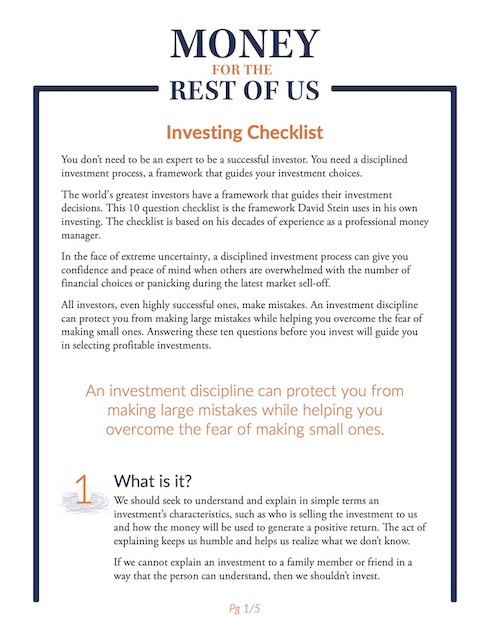Why we need to control the chaos while embracing messiness in living and investing.
In this episode you’ll learn:
- Why specific targets for improvement can lead to unintended consequences.
- Which is more productive: an orderly or messy desk.
- Why we need to embrace messiness both in investing and living.
- How to find the balance between controlling chaos and benefiting from randomness.
Show Notes
Messy: The Power of Disorder To Transform Our Lives – Tim Harford
Economics In One Lesson – Henry Hazlitt
The Poverty of Historicism – Karl Popper
Summary Article
Investing Is Messy
When I was in college, I worked at a large wholesale office products warehouse. Each weekday from 4PM to about 8PM, I would grab a cart, place two large boxes on it, get an order printout and then walk around the warehouse pushing my cart, filling up the boxes with pens, file folders, staplers and other office products.
The completed orders and boxes were then shipped to office products stores in Ohio, Kentucky, and Indiana. There were six other part-time workers who also filled orders. The sooner we got done each day, the sooner we got to go home.
The hurried pace often led to mistakes, such as the wrong color, quantity or wrong product altogether sent to the stores.
Our manager got tired of the mistakes so he came up with a simple solution. He hammered six nails to the wooden cabinets at the front of the warehouse and taped the names of each order picker above a nail so everyone could see them.
Then whenever we made a mistake, he would photocopy the order, highlight the line with the mistake and hang the order on the nail.
Double Checking
As a bright college student, I liked this new game and was sure I wouldn’t make any mistakes. A week later, I wasn’t so confident. I had the second biggest stack of order mistakes on the nail. The guy with the most mistakes got fired, and my job was now at risk.
There was no way I could game this new measurement system. The only way to “win the game” was to not make mistakes. So I slowed down and when I got to the proper shelf in the warehouse, I looked at the order, selected the requested product and then compared the product number and quantity of what what I selected to the product number and quantity on the order before placing the item(s) in the box.
This process of double checking dramatically decreased my mistakes and my nail at the front of the warehouse was generally empty.
Measuring That Leads To Perverse Outcomes
Not every measurement process designed to reduce errors or encourage improvement is as successful as my office product warehouse manager’s solution.
Often the new measurement criteria leads to distortions and doesn’t solve the problem.
For example, in the early 1990s, New York and Pennsylvania introduced a system of report cards showing how doctors and hospitals were performing so patients could make informed choices.
Tim Harford in his book “Messy: The Power of Disorder To Transform Our Lives” relates how four economists looked at the unwelcome side effects of these report cards on elderly patients who had suffered heart attacks. They discovered doctors avoided operations on seriously ill patients who could die, hurting the doctors’ ratings. Instead, doctors preferred operating on patients who didn’t really need surgery but were more likely to survive.
The aim of the report cards was to improve healthcare outcomes, but instead it led doctors to perform more expensive treatments but patients ended up sicker.
Similarly, in the mid 2000s an initiative was launched in the U.K. to improve the responsiveness of the National Health Service, the government funded health care organization. A new target was adopted in which patients would be given an appointment within 48-hours of calling their doctor.
Given the emphasis on the new 48-hour appointment target, the doctors did an excellent job at showing improvement in meeting the target. Unfortunately, the improvement came at the expense of patient satisfaction.
Patients were furious as the only way they could get an appointment with their doctors was to wait on hold for hours at a time because doctors refused to make advanced appointments for routine visits in order to keep their calendars clear for urgent cases.
A simple measurement target to foster improvement worked well in the contained environment of an office products warehouse where the task at hand was relatively straightforward.
Simple measurement targets led to perverse outcomes in the medical profession because healthcare is significantly more complex with multiple competing priorities.
When simplistic rules and targets are applied to complex domains it often leads to distortions and perverse outcomes. Tim Harford writes, “the trouble is when we start quantifying and measuring the world, we soon begin to change the world, to fit the way we measure it.”
Notice the distortions arise because “we soon begin to change the world.”
The Difference Between Avalanches and People
Targets and checklists can work quite well to analyze complex phenomena such as the risk of an avalanche. Skiers can avoid getting caught in avalanches by looking for obvious clues such as have avalanches recently been reported in the area, is there evidence of melting on the surface, and has there been a recent rain or snowfall.
The difference with a natural phenomena such as an avalanche compared to people and institutions is avalanches don’t change their behavior in response to being measured.
Financial markets and the economy are complex adaptive systems like avalanches but because they involve people they are also subject to distortions such as bubbles, contagions, recessions and exuberance.
Looking For Obvious Clues
While there are obvious clues to identify distortions like asset bubbles, it is not always obvious when bubbles will burst. That depends on the behavior of investors.
At the same time there is a great deal of randomness and chaos within financial markets, making it difficult to predict how markets will perform from day-to-day, week-to-week and month-to-month.
Consequently, investing can get messy. By having diverse portfolios spread among different asset types, investors can benefit from the randomness inherent in financial markets.
In addition, investors should also be on the lookout for obvious clues of distortions such as asset bubbles or severe undervaluations and be flexible enough to adapt their portfolios to avoid/benefit from these distortions.
Distortive events like the Internet bubble in the late 1990s and the real estate bubble and Great Recession in the last decade are rare. But they do occur and it pays to be vigilant in looking for the obvious clues.

